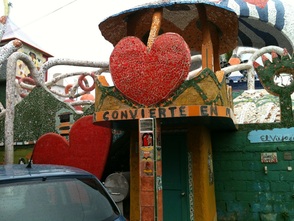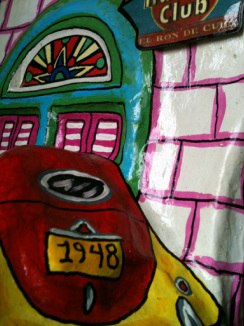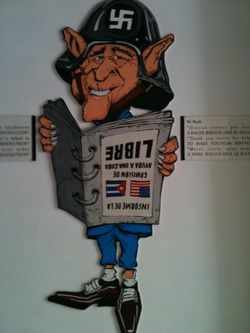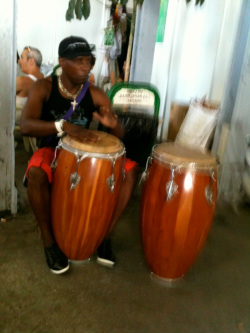
Gaudy Gaudi – That’s my nickname for the mosaics decorating 80 houses in the barrio of Jaimanitas on the outskirts of Havana. Created by renowned Cuban artist José Fuster using tiles and bits of discarded stones and glass, the run down community is transformed into color and dreaminess.
Peeling paint – Over the years, salt air has stripped away paint and now different layers of color give each building its own look. Paint is hard to come by because of the U.S. blockade (bloqueo in Spanish)

"In Cuba, the first letter in the license plate indicates which of 14 provinces the car hails from, such as "H" for Havana. The letter "K" means the car is privately owned -- either by a person or by a foreign firm. Military vehicles have mint-green, rear-only plates; olive-green plates are for vehicles issued by the Ministry of the Interior, including Fidel Castro's fleet of armored Mercedes 280s, which were built between 1982 and 1984. Black plates are for foreign diplomats, who don't have to adhere to traffic laws. White-plated vehicles are driven by Cuban government ministers or heads of state. The last three digits on diplomatic plates often denote the professional rank of the driver. So, if you're stuck behind a gray Mercedes with black license plate 179-004, that means the fourth most-important officer from the Russian embassy is likely behind the wheel. Rental cars get maroon plates. Foreign journalists, religious leaders and Cubans working for overseas firms have neon-orange ones. Red "provisional" plates allow vehicles to circulate while authorities sort out just what color tag they should get. Most of the half-century-old American roadsters that create a moving museum along the island's potholed streets have yellow license plates, meaning they are vehicles owned by ordinary Cubans.
"Detroit's chrome-and-tail-fin era cars are still prominent on the roads because Cubans with non-VIP jobs can buy and sell only cars manufactured before the Castros took power in 1959. Buying newer vehicles requires government permission, including justifying how you can afford a car when the communist state controls well over 90 percent of the economy and pays employees an average of about $20 a month.” philSTAR.com

Propaganda – With few products to sell, billboard space and walls sell the revolution. My favorite anti-imperialist blast seen in Havana on the way to the airport translates, “Blockade: the longest lasting genocide in history.” Of course, Ernesto Che Guevara’s face is for sale on every visible surface from tea cups to bibs, and one sees the less familiar face of Camilo Cienfuegos, a revolutionary who fought along with Fidel. Officially, America is a villain; personally, I felt cared for.
Tour Buses – Big, made in China or Russia and owned by the state. Perfumed, air conditioned and faithful to their schedules. Drivers politely assist passengers at each stop.
Alcohol – Pina Colada –Blend Havana rum, cream of coconut and pineapple juice with crushed ice until smooth. Garnish with a pineapple slice and a maraschino cherry. As for a Mojito, take a generous sprinkling of sugar and add the juice of half a lime and some scrunched up mint leaves, mix it up, pour on a stiff measure of light dry rum and add soda water and ice... and serve with a straw. Both drinks available almost anywhere, even bus stops on the way to and from hotels.

Food – not very good. Because we were 74, plus guides and drivers, not many restaurants could accommodate a group our size. Restaurants are mostly state-owned and while the service is kind, the food is not especially good even if you like rice and beans, called Christians and Moors because of the colors of the rice and the beans. For smaller groups dining out, private restaurants called paladares offer food in people’s homes. I ate pizza one night at 9:30 p.m. in a small outdoor restaurant three blocks from the Copacabana Hotel where we stayed the first three nights of our visit. The cook said no fresh tomatoes that night. It was okay though.
 RSS Feed
RSS Feed